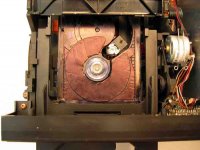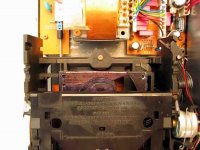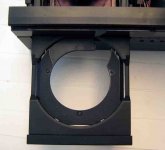I_Forgot said:
It depends on what type of error triggers the LED. The vast majority of errors that occur in reading CDs are 100% correctable by the electronics before the data stream gets to the DAC. Such errors don't matter at all. The next level of error is one that can't be corrected, so the data is interpolated. These errors are very brief and your ability to recognize them is directly proportional to the size of your audio ego. The third type of error is what happens when you have a long scratch in the disc or a big glop of peanut butter on the disc- there aren't enough good samples to interpolate so the output is muted.
Which type triggers the LED?
I_F
Is this done in the decoder chip?
Is there any relevance to the types of decoders and the way they decode?
Or are they set by the Redbook standards?
allan
There's a pretty good explanation in the "data storage" section here:
http://en.wikipedia.org/wiki/Reed-Solomon_error_correction
I_F
http://en.wikipedia.org/wiki/Reed-Solomon_error_correction
I_F
Yes, I think it (all three stages of error correction) is done on the decoder chip. I did hear a myth once that not all stages are performed by all CDPs, but I've already called that a myth.
I admit that you'd be unlucky to hear a corrected error, hamming codes really do fix most of them.
I've got my head stuck in a DAC PSU at the moment (its sort of wedged between a rectifier and a toroid ), but if I find the time, I might give the error LED a whirl (would like to mount it nicely on my transport I think, so shouldn't rush it).
), but if I find the time, I might give the error LED a whirl (would like to mount it nicely on my transport I think, so shouldn't rush it).
I_F, the Philips CD104 has an error LED. I reckon a few other early Philips CDPs might have them too.
I admit that you'd be unlucky to hear a corrected error, hamming codes really do fix most of them.
I've got my head stuck in a DAC PSU at the moment (its sort of wedged between a rectifier and a toroid
I_F, the Philips CD104 has an error LED. I reckon a few other early Philips CDPs might have them too.
Another point that hasn't been mentioned yet: The drive doesn't spin at constant revolutions as compared to a record player. Whereas an increased mass would help in the case of the record player it wouldn't help the CD player at all.
Speed is controlled by a control loop as already mentioned. You are likely to f*** up the stability of this control loop if you increase inertia. And while you can regain (static !) stability by increasing an integrator C you are most likely to make the dynamic properties of the control loop worse. Quite the contrary of what you would like to achieve and this would actually make the task of the buffers harder and not easier.
The whole thing could be compared a little to someone "improving" a given amp design by using slower output devices than originally intended and then increasing the dominant pole compensation cap.
Regards
Charles
Speed is controlled by a control loop as already mentioned. You are likely to f*** up the stability of this control loop if you increase inertia. And while you can regain (static !) stability by increasing an integrator C you are most likely to make the dynamic properties of the control loop worse. Quite the contrary of what you would like to achieve and this would actually make the task of the buffers harder and not easier.
The whole thing could be compared a little to someone "improving" a given amp design by using slower output devices than originally intended and then increasing the dominant pole compensation cap.
Regards
Charles
Interesting reading
thank you I_Forgot
more than 2 byte in 32 then dump it
performs better in burst mode.
adding mass too the cdrom is not going to help, stopping the cdrom from vibrating should help tracking but not at the expense of mass.
the disc needs to change speed,
main thing to do to the decoder is clock and Iref.
Hmm need to study this a bit more, reminds me of MH, MR and MMR in Facsimile stuff.
allan
thank you I_Forgot
more than 2 byte in 32 then dump it
performs better in burst mode.
adding mass too the cdrom is not going to help, stopping the cdrom from vibrating should help tracking but not at the expense of mass.
the disc needs to change speed,
main thing to do to the decoder is clock and Iref.
Hmm need to study this a bit more, reminds me of MH, MR and MMR in Facsimile stuff.
allan
Error Light
My NAD 5300 monitor series has two error lights (one yellow, one red). I have no manual avaiable but I think the yellow one shows errors of the second level; the red one of the third level.
My obeservations:
When the red one lights up it can mostly be heard. If it often lights, its frequently stops playing the CD.
The yellow one turns on on CD-R's much more often than on CD's. The aging of CD-R's can be monitored by seeing the yellow coming on more often and often. With some CD-R's it's almost constantly on.
greetings, MArco
It depends on what type of error triggers the LED. The vast majority of errors that occur in reading CDs are 100% correctable by the electronics before the data stream gets to the DAC. Such errors don't matter at all. The next level of error is one that can't be corrected, so the data is interpolated. These errors are very brief and your ability to recognize them is directly proportional to the size of your audio ego. The third type of error is what happens when you have a long scratch in the disc or a big glop of peanut butter on the disc- there aren't enough good samples to interpolate so the output is muted.
My NAD 5300 monitor series has two error lights (one yellow, one red). I have no manual avaiable but I think the yellow one shows errors of the second level; the red one of the third level.
My obeservations:
When the red one lights up it can mostly be heard. If it often lights, its frequently stops playing the CD.
The yellow one turns on on CD-R's much more often than on CD's. The aging of CD-R's can be monitored by seeing the yellow coming on more often and often. With some CD-R's it's almost constantly on.
greetings, MArco
Thanks for the interesting comments on increasing the inertia of the CD. I suppose the manufacturing equipment writes the stream of bits (pits) at a very constant pace, with minimal mechanical jitter. At the playback, the disc rotates at variable angular speed. The readout bit stream is written in a RAM buffer, and the amount of data in the buffer changes with the speed fluctuation. This is nothing to do with error correction which comes in a subsequent phase, but somehow I "feel" that less speed variance were better.
As for the error correction, I mounted a LED in my Marantz CD-84 nicely in the middle of the mains swith button. It is connected to pin 3 of the SAA7020 error corrector chip via a transistor. This is the C1 decoder error flag. There is also an uncorrectable error flag output at pin 36, I connected that to the same LED (later I will change it to a yellow/red dual LED as Marco suggested. I have exactly the same experience as him: written discs blink often, and some very good sounding audiophile CDs do so. Some scratched inferior sounding CDs never lit the LED up.
As for the error correction, I mounted a LED in my Marantz CD-84 nicely in the middle of the mains swith button. It is connected to pin 3 of the SAA7020 error corrector chip via a transistor. This is the C1 decoder error flag. There is also an uncorrectable error flag output at pin 36, I connected that to the same LED (later I will change it to a yellow/red dual LED as Marco suggested. I have exactly the same experience as him: written discs blink often, and some very good sounding audiophile CDs do so. Some scratched inferior sounding CDs never lit the LED up.
This is nothing to do with error correction which comes in a subsequent phase, but somehow I "feel" that less speed variance were better.
I think the wrong assumption here is that an increased mass would reduce the speed variance in the first place.
Regards
Charles
Instead of increasing the inertia, I have wondered if a better opamp driving the turntable motor would help (another thing I wanted to try, but didn't get round to it).
My CD940 has an SAA7310, which (I think) only has a single error pin (pin1 - EFAB). Still worth attaching though I think.
My CD940 has an SAA7310, which (I think) only has a single error pin (pin1 - EFAB). Still worth attaching though I think.
philpoole said:Instead of increasing the inertia, I have wondered if a better opamp driving the turntable motor would help (another thing I wanted to try, but didn't get round to it).
My CD940 has an SAA7310, which (I think) only has a single error pin (pin1 - EFAB). Still worth attaching though I think.
which package is your 7130
Before the opamp make sure the volt's and clock is clean, page 8 in the data sheet.
allan
Hi Allan,
Its the surface mount package. BTW you did mean 7310 right?
The clock's good. Its a Kwak clock fed straight into the decoder chip. Everything after the decoder has been disabled, so the power to the decoder isn't bad (there's only the CPU alive on the board), but could still be improved.
Cheers,
Phil
Its the surface mount package. BTW you did mean 7310 right?
The clock's good. Its a Kwak clock fed straight into the decoder chip. Everything after the decoder has been disabled, so the power to the decoder isn't bad (there's only the CPU alive on the board), but could still be improved.
Cheers,
Phil
philpoole said:Hi Allan,
Its the surface mount package. BTW you did mean 7310 right?
The clock's good. Its a Kwak clock fed straight into the decoder chip. Everything after the decoder has been disabled, so the power to the decoder isn't bad (there's only the CPU alive on the board), but could still be improved.
Cheers,
Phil
I,am going to play with the cd850 with Lc xo3 thats been in there for a while now.
use it as a transport for external dac via I2s
on you package type look at Pin 29, 30, 31.
If these are noisy? what happen
I swopping between 7210 and 7310 datasheets at present, just looking to see what infuences what.
allan
phase_accurate said:Another point that hasn't been mentioned yet: The drive doesn't spin at constant revolutions as compared to a record player. Whereas an increased mass would help in the case of the record player it wouldn't help the CD player at all.
Speed is controlled by a control loop as already mentioned. You are likely to f*** up the stability of this control loop if you increase inertia. And while you can regain (static !) stability by increasing an integrator C you are most likely to make the dynamic properties of the control loop worse. Quite the contrary of what you would like to achieve and this would actually make the task of the buffers harder and not easier.
The whole thing could be compared a little to someone "improving" a given amp design by using slower output devices than originally intended and then increasing the dominant pole compensation cap.
Regards
Charles
hi, phase_accurate.
I get the similar point as u, but I can only name that a myth now, I'll look for more articles to get it clean...
I don't think there's much dispute that inertia isn't improving the situation, but mechanical damping may well be helping, like with the rest of the transport. The transport does make a difference, and it is a mechanical as well as electronic device.
Allan, I'm doing pretty much the same as you. My CD940 is just a transport, everything else is disabled on it, and it has a Kwak clock feeding the decoder directly.
The I2S is converted to three differential signals which I output on twisted pairs to my DAC, which is external.
Its the best setup I've had to date.
My DAC is a NOS 1541A based, and a bit of a prototype at the moment, but I'm building a new one with its own dedicated supply.
Allan, I'm doing pretty much the same as you. My CD940 is just a transport, everything else is disabled on it, and it has a Kwak clock feeding the decoder directly.
The I2S is converted to three differential signals which I output on twisted pairs to my DAC, which is external.
Its the best setup I've had to date.
My DAC is a NOS 1541A based, and a bit of a prototype at the moment, but I'm building a new one with its own dedicated supply.
oshifis said:.................At the playback, the disc rotates at variable angular speed. The readout bit stream is written in a RAM buffer, and the amount of data in the buffer changes with the speed fluctuation. This is nothing to do with error correction which comes in a subsequent phase, but somehow I "feel" that less speed variance were better.................
You are missing the point.
While the speed of rotation of the disk varies with which track is being played ( ie outer track - slower, inner track - faster ), the data rate is constant so the amount of data in the buffer is constant.
The whole thing is servo controlled, locked by a PLL to the clock. The servo amplifier compares the 'error' signals to a reference voltage.
So, inertial has nothing to do with speed variance! Indeed, messing with the inertia of the system will mess it up as has been mentioned above.
As I said before, to improve the system in this area :-
Improve the power supply to reduce voltage variations and cross interference.
Improve the reference voltage.
Improve the clock.
Clean up the HF/RF signal.
Dampen the system and improve acoustic isolation.
Andy
tabooes said:
hi, phase_accurate.
I get the similar point as u, but I can only name that a myth now, I'll look for more articles to get it clean...
It's rather the other way around. This thread is based on the assumption that something is wrong and needs to be fixed.
- Status
- This old topic is closed. If you want to reopen this topic, contact a moderator using the "Report Post" button.
- Home
- Source & Line
- Digital Source
- Increasing CD platter inertia


